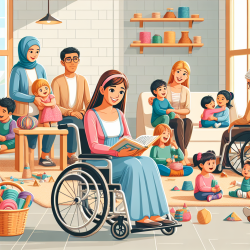In the realm of speech-language pathology, understanding and nurturing the vocabulary development of bilingual children is a complex but rewarding endeavor. The recent study, "Parental reports on the lexicon of children from diverse bilingual populations," provides invaluable insights that can significantly enhance the practice of speech-language pathologists (SLPs). This blog delves into the study's findings and offers practical applications for SLPs working with bilingual children.
Understanding Bilingual Vocabulary Development
The study conducted by Ohana and Armon-Lotem (2023) focused on 90 bilingual children from English-Hebrew, French-Hebrew, and Russian-Hebrew speaking families. Using a multicultural adaptation of the MacArthur-Bates Communicative Development Inventories (MB-CDI), parents reported on their children's vocabulary in both their home language (HL) and societal language (SL-Hebrew). The key findings include:
- No significant difference in vocabulary size between HL and SL for both production and comprehension.
- Balanced bilingualism at the group level across all three language groups.
- Correlations between language exposure, use, and various vocabulary measures.
Practical Applications for SLPs
Based on these findings, here are some data-driven strategies SLPs can implement to improve outcomes for bilingual children:
1. Comprehensive Assessment Using Parental Reports
Parental questionnaires, like the MB-CDI, are effective tools for assessing bilingual children's vocabulary. SLPs should leverage these tools to gain a holistic understanding of a child's vocabulary across both languages. This approach ensures that both HL and SL are considered, providing a more accurate assessment.
2. Tailoring Interventions Based on Exposure
The study highlights the critical role of language exposure in vocabulary development. SLPs should consider the amount and context of language exposure when designing interventions. For instance, if a child has limited exposure to SL-Hebrew, incorporating more Hebrew language activities at home and in therapy sessions can be beneficial.
3. Encouraging Literacy Activities
Exposure to books and screens in a particular language positively correlates with vocabulary in that language. SLPs should encourage parents to engage in literacy activities in both HL and SL. This dual-language approach can enhance vocabulary development and support balanced bilingualism.
4. Addressing Individual Variability
The study found significant individual variability in vocabulary levels. SLPs should tailor their interventions to address the unique needs of each child. This personalized approach ensures that children receive the support they need to thrive in both languages.
Encouraging Further Research
While this study provides valuable insights, it also underscores the need for further research. SLPs are encouraged to contribute to this growing body of knowledge by conducting studies in diverse bilingual populations. This research can help refine assessment tools and intervention strategies, ultimately improving outcomes for bilingual children.
To read the original research paper, please follow this link: Parental reports on the lexicon of children from diverse bilingual populations.










